Hello to all the Gibbes blog readers! My name is Zinnia Willits and I am the Collections Manager here at the Gibbes. What is a Collections Manager you ask? In the simplest terms, I manage the museum’s art collection and make sure it is well cared for whether in storage, on exhibit, or on loan to another museum. There are many facets to this job; continue to read our blog and you will get a glimpse of some of them! I will be posting occasionally about work we do behind-the-scenes to bring you the spectacular exhibitions you have come to expect from the Gibbes. A great deal of planning, time, muscle, and design goes into each exhibition we present. Everything from object placement to gallery color to light levels has been carefully considered. We have a great exhibit team here at the Gibbes. Our staff is small but dynamic and we are used to working hard to achieve great things!

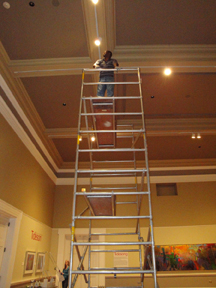
Today I want to talk a little bit about traveling exhibitions that invovle artwork on loan to the Gibbes.
How does artwork travel to the Gibbes?
Most artwork borrowed for exhibition is transported to the Gibbes via fine art shipping. Fine art shipping is the safest way to move art from point A to point B. All art trucks are climate controlled, have air-ride suspension and lift gates, state-of-the-art security systems, and are driven by trained art handlers.

Those not familiar with art shipping are usually shocked when they find out the cost to transport a small crate a short distance. Yes, it’s expensive, but so is the artwork. Every precaution is taken to protect works moving across the state, country, or world. The peace of mind fine art transport provides both lender and borrower is priceless. Art shipping has grown into a booming industry complete with its own professional organizations and conferences.
Packing Art for Transit: Crates
Most exhibitions are packed for transit in one of two ways: crated or soft-packed. Museum-quality crates are built for works that are extremely fragile or have to travel long distances for long stretches of time. Building travel crates is an art form in itself and is carried out with precision and high quality materials. Many fine art shipping companies provide crate construction services. These days it is wise to have a fine art company build your crates as there are numerous shipping restrictions (with more added every day) on the types of wood that can be used, size of crates that can travel via air, method of packing, etc. Depending on the nature of the artwork, crates are usually lined with archival, custom-fit materials with names such as Tyvek, Ethafoam, or Volara and have impact-resistant fiberglass or plywood walls.
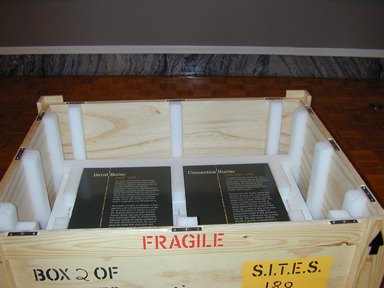
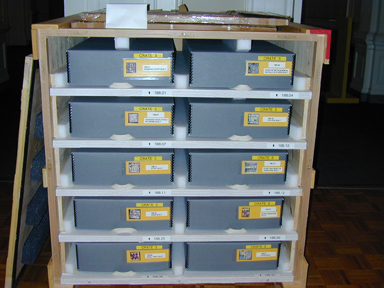
Crates can be simple (for two-dimensional artwork) or complex (such as those constructed for ceramics or sculpture). Specialized crates can be outfitted with a travel frame designed to protect paintings with fragile surfaces. Travel frames attach to the back of a painting and allow free space around the face and sides of the work making it possible to pack and unpack with very little handling.
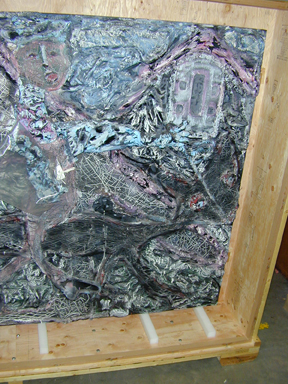
Packing Art for Transit: The “Soft-Pack”
One final comment on museum crates. They are expensive. That being said, there is an alternative to crating: the soft-pack. Yes, this is a made-up word, but those of us who deal with art shipping use it quite a bit. Soft-pack can be an acceptable packing solution but one must consider the condition, medium, and fragility of a work, how long it will travel, how far it will travel, and what mode of transportation it will take. Although soft-pack styles vary, there are basic guidelines for understanding what this means. Generally, to soft-pack a work means to wrap it with a moisture barrier (such as plastic, glassine, or bubble wrap) and then create a custom box (usually made from sheets of cardboard) to surround the artwork. This is also referred to as a slip case.

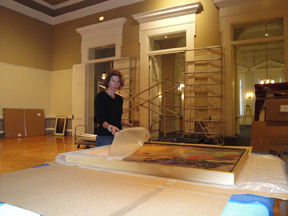
Soft-packing works for transit is cost-effective and can be done safely. The current exhibition of works by Brian Rutenberg arrived in slip cases. This type of packing made the most sense for these paintings. They are in excellent condition and shipped directly from the Jerald Melberg Gallery in Charlotte, North Carolina to the Gibbes. They will return in the same direct manner when the exhibition closes in January. The Melberg Gallery created top-of-the-line slip cases and added special touches such as padded frame corners and folded tape edges which made unpacking much easier!
So there you have it, some information on art packing and transit and a sneak peek at our galleries in the midst of installation. There are other cool things we do to make the exhibitions great but more on that in the next installment of Behind-the-Scenes at the Gibbes. By the way, if there is something you want me to write about or you have a question about art handling, storage, transportation, packing, etc. feel free to post a comment here or drop me an email at [email protected].
Published December 11, 2009

